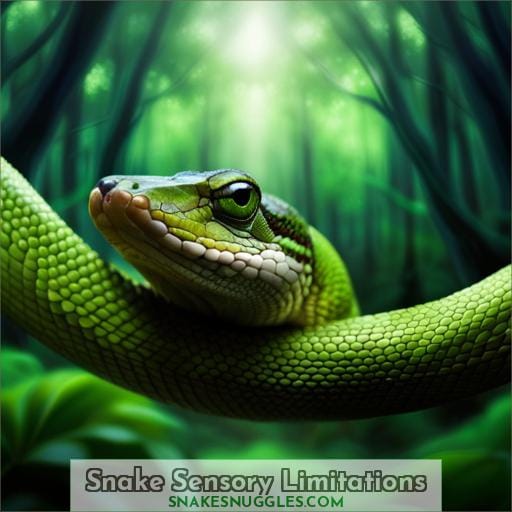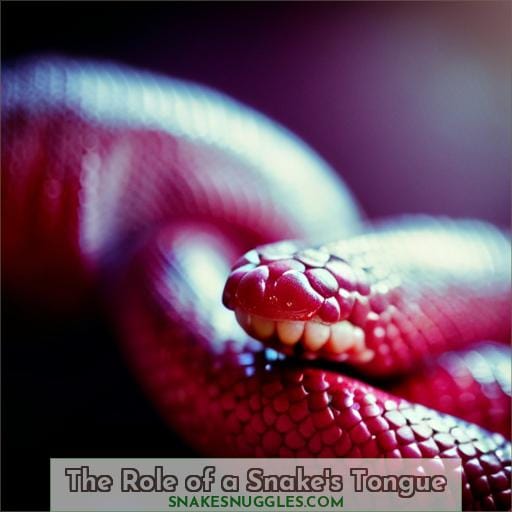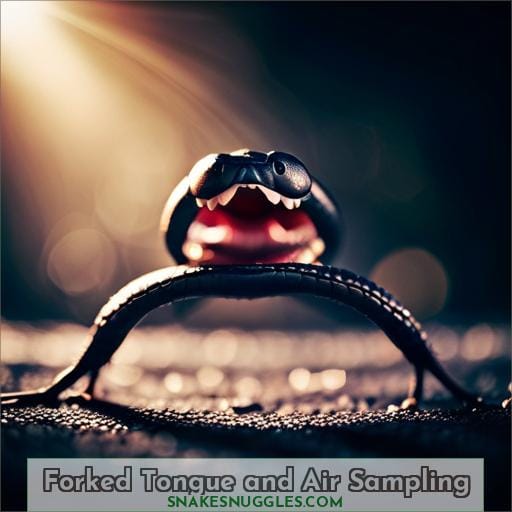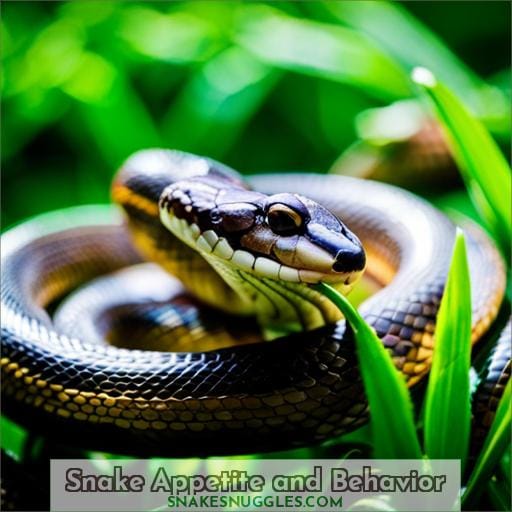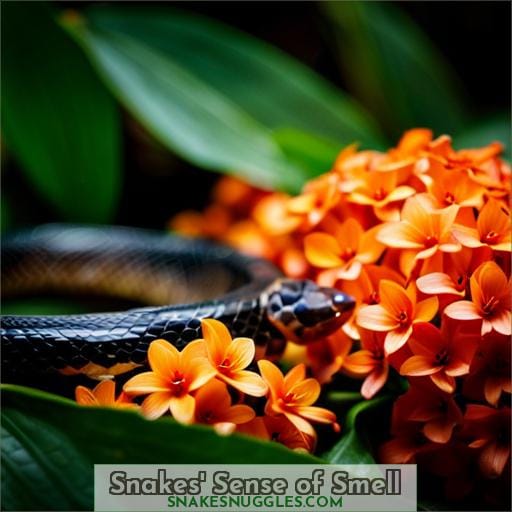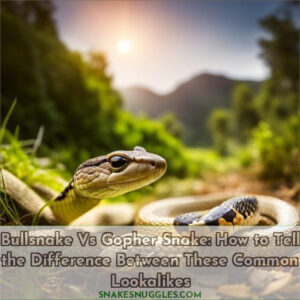This site is supported by our readers. We may earn a commission, at no cost to you, if you purchase through links.
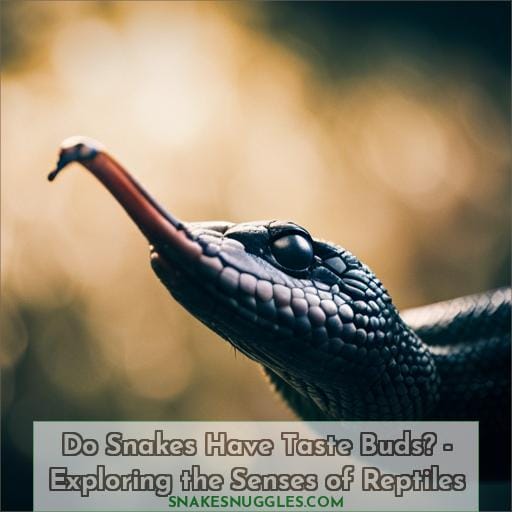 Do you know if snakes have taste buds? It’s an interesting question that has puzzled many. The answer is no, but there are other ways in which they sense their environment and food.
Do you know if snakes have taste buds? It’s an interesting question that has puzzled many. The answer is no, but there are other ways in which they sense their environment and food.
Snakes lack the outer ear, eardrum, and strong eyesight of humans – all of which limit their senses of touch due to hard scales on their skin – yet still manage to survive with six remaining senses: smell, hearing through vibrations in the ground or air; taste (in a different way than we do); sight; temperature sensing pits; and balance/acceleration.
To explore this further let’s look at how snakes use their tongue for sampling air from various directions as well as how they rely heavily on scent detection using a combined effort from nostrils, tongue-flicking gestures, and Jacobson’s organ located inside its mouth roof cavity for tasting – compensating for poor vision with an acute sense of smell!
We will also discover what factors affect snake appetite such as stress levels during shedding cycles or attraction to specific smells when it comes time to eat.
Table Of Contents
Key Takeaways
- Snakes lack traditional taste buds but possess unique sensory adaptations.
- Their primary senses include smell, vibrations, and heat detection.
- Snakes use their sense of smell to detect their environment and locate prey.
- Snakes have evolved a remarkable array of sensory adaptations to compensate for their lack of taste buds and limited conventional senses.
Snake Sensory Limitations
Snakes don’t have the same sensory capabilities as humans. Their lack of an outer ear, eardrum, and strong eyesight limit their perception of sights and sounds. Additionally, due to hard scales covering their body, snakes’ sense of touch is limited.
As a result, they rely on smell and ground vibrations for more accurate information about their environment.
Lack of Outer Ear, Eardrum, and Strong Eyesight
You rely on smell and vibrations to perceive your surroundings due to a lack of external ears, eardrums, or strong vision. Your hard scales help you identify objects through touch, while your sense hierarchy allows for efficient hunting behavior.
Taste buds are absent from your tongue; instead, it is used to collect scents with the aid of the rostral groove in your upper lip. Your sense of smell helps locate prey via scent trails, as well as dens and mates with pheromones, while Jacobson’s organ identifies tastes and smells from tongue input connected to the nasal cavity in its roof.
Limited Sense of Touch Due to Hard Scales
Your hard scales limit your sense of touch, making it difficult to detect subtle changes in the environment. You rely mainly on smell and ground vibrations for sensory input, with taste-smell identification aided by Jacobson’s organ.
Heat detection allows you to find warm spots for basking or locating prey. Pheromones stimulate olfactory senses, allowing you to track mates and dens through scent trails – a vital part of the sensory hierarchy that helps make up for poor eyesight.
Your gustatory receptors are absent from your tongue but still allow lethal toxins like venom gland secretions to be detected even without direct contact! Olfactory organs, combined with heat detection, help form an efficient system used to survive in a perilous world – one where touch limitations can have dire consequences if not navigated properly.
The Role of a Snake’s Tongue
You may have heard that snakes can taste their prey with their tongue, but did you know they don’t actually have taste buds? Instead, snakes use the groove on the top lip to facilitate movement of the tongue and detect chemicals in their environment.
Furthermore, contrary to popular belief, a snake’s tongue is not used for stinging—it only helps them sense smells. Snakes lack any smell receptors or taste buds on their tongues, which makes flicking necessary for scent collection.
The Groove in the Top Lip for Tongue Movement
Experience the remarkable process of a snake’s tongue movement with its upper lip groove. Snakes possess mouth bristles and a unique sensory organ, Jacobson’s Organ, to detect scents from their environment.
By flicking their tongues in rapid succession, they are able to follow scent trails that lead them to prey or mates. They can also sense heat detection and use this information for hunting purposes, as well as debunking common myths about snakes, like do snakes have taste buds? This powerhouse combination of senses gives them an advantage over other predators in the wild, allowing them to survive and thrive despite limited vision compared to humans.
Dispelling the Myth of Snake Stinging With Their Tongue
Contrary to popular belief, snakes do not sting with their tongues. Instead, they use the groove in the top lip of their mouths and tongue-flicking movements to collect scents from chemicals and pheromones left behind by prey.
The Jacobson’s organ helps identify smells that lead snakes along scent trails while also detecting taste or smell input from its tongue. This unique anatomy allows them to track down food sources as well as locate dens for mating purposes or hibernation periods without needing sight or sound information like other animals heavily rely on.
Snakes can sense a variety of odors thanks to this specialized adaptation!
Lack of Smell Receptors and Taste Buds on the Tongue
You may be surprised to learn that, despite lacking smell receptors and taste buds on its tongue, a snake’s ability to detect scents is enhanced by its unique forked structure. Its two-pronged anatomy helps it sample air from different directions, and tongue flicking increases scent detection accuracy.
Jacobson’s organ aids in identifying smells and tastes, while the upper lip groove collects air samples.
Forked Tongue and Air Sampling
You may have heard that snakes don’t have taste buds, but they do possess a unique adaptation for collecting air samples from different directions – their forked tongue. By flicking their tongues in and out of their mouths, they can sample scent molecules in the environment to detect prey or predators.
Snake tongue length is also an important factor when it comes to accurate scent detection; longer tongues are better able to cover more ground quickly, while shorter ones work better in confined areas.
Forked Tongue Collecting Air Samples From Different Directions
By flicking their forked tongue in different directions, snakes can collect air samples and gain information about their environment. This helps them detect prey with chemical cues, as well as pheromones that aid in mate-finding and den location.
The forked shape of the tongue allows it to sample from two places at once, a sense known as snake smell-tasting. Its oscillations also enhance scent collection by allowing the snake to track scents over time.
Snakes rely heavily on senses other than sight or sound due to limited eyesight and lack of ears, making this adaptation crucial for survival.
The Relationship Between Tongue Length and Scent Detection
Experience the unique connection between a snake’s tongue length and its scent detection capabilities! Licking frequency varies depending on the type of snake; venomous snakes often flick their tongues more rapidly than non-venomous species.
This helps them detect pheromones, identify food sources, and track prey through scent trails.
The vomeronasal organ in their mouths allows for smell detection too, with both organs working together to aid sensory adaptation. Snakes have an incredibly acute sense of smell compared to humans – even without taste buds – making them incredibly adept hunters.
Their remarkable ability is thanks in part to our evolutionary ancestors: human Jacobson’s organ may also play a role in this sensory hierarchy as well!
The Jacobson’s Organ
You may have wondered how snakes can detect their food even though they don’t possess any taste receptors on their tongue. The answer lies in the Jacobson’s organ, a unique adaptation found in many species of reptiles and amphibians.
This small structure is located at the roof of the mouth and connects to its nasal cavity, allowing it to sense both taste and smell input from the tongue. It serves as an important part of snakes’ sensory hierarchy where smell takes precedence over sight due to visual limitations like weak eyesight or lack of external ears.
Thanks to this organ, these animals are able to not only identify tastes or smells but also track prey through scent trails using forked tongues that collect air samples from multiple directions while oscillating rapidly.
Furthermore, certain pheromones help them locate dens for breeding purposes as well as potential mates during mating season, which affects snake behavior such as appetite fluctuations when stressed out or undergoing shedding cycles.
So despite not having taste buds on their tongues, snakes still have a wide range of thermal detection capabilities combined with extremely sensitive senses that help them survive in different environments.
Snake Appetite and Behavior
Snakes have an extraordinary sensory system that allows them to be incredibly efficient hunters and survive in the wild. Their attraction to specific smells for eating, combined with factors such as stress and shedding, all contribute to their appetite and behavior.
Attraction to Specific Smells for Eating
With their forked tongues and keen sense of smell, snakes can detect specific smells that attract them to potential meals! They use a hierarchy of senses such as vision, heat detection, and pheromone tracking to smell chemicals in food.
Their nostrils are also able to pick up on subtle scents, which help with hunting behavior. By using the serpent’s sense of smell, it is easy for them to track prey or locate dens.
Furthermore, the tongue helps enhance scent collection by flicking from different directions, allowing accurate sensing hierarchy.
Factors Affecting Appetite, Such as Stress and Shedding
Stress, illness, and shedding can all influence a snake’s appetite by changing its frequency of tongue flicking. Hunger signs, such as restlessness or increased tongue flicking, indicate that the animal needs food.
Snakes rely on Jacobson’s organ to sense taste and smell input from the tongue, compensating for their weak eyesight. The vomeronasal organ allows snakes to identify tastes and smells through the connection between the brain, nose, and mouth, even when there is no appetite loss due to external factors like stress or sickness.
Snakes’ Sense of Smell
Snakes have a unique sense of smell that allows them to compensate for their poor eyesight. They use tongue flicking, nostrils, and the Jacobson’s organ in combination to detect scents. This remarkable adaptation enables snakes to track prey and locate dens effectively by picking up scent trails from different directions.
Use of Tongue, Nostrils, and Jacobson’s Organ for Smelling
By flicking their tongues and using the rostral groove, nostrils, and Jacobson’s organ in their mouths, snakes rely heavily on smell to explore. They sample air with chemicals that contain tastes or smells for identification.
The vomeronasal organ connects to the nasal cavity and detects these substances from the tongue, then sends signals to the brain. There could even be stimulation of pheromones through this process! Snakes’ sense of hierarchy puts a greater emphasis on smell than sight due to the absence of taste buds, though it still has its unique adaptations like heat detection too! This all helps them find prey or mates more effectively by tracking scents across different directions via oscillating fork-like movements of their tongue tips.
Compensating for Poor Eyesight With a Strong Sense of Smell
As you navigate the world, your sense of smell is key in helping you make up for poor eyesight. Snakes are no different—they rely on tongue flicking and their Jacobson’s organ to detect scents around them.
This air sampling helps snakes identify prey as well as locate dens and mates using pheromones. Without taste receptors, they must use these unique adaptations to identify tastes and smells in order to survive.
The combination of tongue oscillations with scent detection allows them more precise tracking than just relying on nostrils or a single fork-tongue flick would provide—a truly remarkable adaptation! Snakes’ ability to distinguish between various smells enhances their already impressive array of senses used for efficient hunting and survival despite limited color vision compared with humans.
Unique Snake Adaptations
Snakes are fascinating creatures with unique adaptations that help them survive in the wild. They possess six senses, including smell, taste, sight, touch, hearing, and heat detection – coupled with limited color vision compared to humans – which aid their hunting and survival skills.
Six Senses Aiding Hunting and Survival
You can marvel at the amazing way snakes use their six senses for hunting and survival. They employ taste, smell identification, sight, touch, hearing, and heat detection to track prey. The tongue helps detect scents through flicking, while Jacobson’s organ aids taste-smell identification in the mouth’s roof.
Snakes heavily rely on scent since they lack external ears or strong eyesight. This sensory hierarchy is key to efficient hunting. Vomeronasal organs play an important role in identifying smells, with help from air samples collected by a groove in the upper lip of reptiles like snakes.
Limited Color Vision Compared to Humans
Unlike you, snakes have limited color vision and rely on other senses for hunting and survival. They use chemical detection to sense prey through tongue flicking and taste receptors from their Jacobson’s organ.
They also use pheromones to identify potential mates or dens. This sensory hierarchy helps them find food despite poor eyesight, relying more heavily on scents than sights! Snakes flick their tongues rapidly to collect air samples, which are then sent back into the vomeronasal organ for interpretation.
Frequently Asked Questions (FAQs)
Do snakes need to eat to survive?
Yes! Snakes need to eat in order to survive. Their sensory adaptations, such as tongue-flicking and Jacobson’s organ, help them track prey through scent trails and locate food sources. Eating is essential for snakes – it gives them the energy they need to hunt and stay healthy.
Do snakes have the ability to detect temperature changes?
Yes, snakes have the ability to detect temperature changes! Just like a ‘hot potato’, they can pick up on subtle variations in heat. Snakes do this by using their unique adaptations such as infrared sensors and pit organs located near their eyes that allow them to sense thermal radiation.
How do snakes find their prey?
Snakes rely on their forked tongue and Jacobson’s organ to find prey. Flicking the tongue in different directions, they collect scent particles which are then processed by these organs – allowing them to track odors from far away and hone in on their target.
Does Jacobson’s organ help snakes in their day-to-day activities?
Yes, Jacobson’s organ helps snakes in their day-to-day activities. This sensory adaptation aids them in sensing tastes and smells to identify prey, track dens, and find mates using pheromones. Its presence also allows for efficient hunting by collecting scents from different directions with its forked tongue.
Is there any evidence that snake’s can sense human pheromones?
Snakes’ sense of smell is like a powerful magnet, able to pick up on human pheromones from surprising distances. Evidence suggests that they can detect these scents and use them for hunting or finding mates.
Jacobson’s organ plays an important role in this process, allowing snakes to identify smells more accurately than other animals could ever hope to.
Conclusion
You may have heard the myth that snakes can sting with their tongues, but it’s just that – a myth. The truth is, snakes’ tongues are actually an incredible adaptation that helps them to survive. They lack external ears, eardrums, and strong eyesight, so they rely heavily on their sense of smell and their ability to detect ground vibrations.
The tongue is the primary tool for collecting scent information, with the groove in the top lip aiding movement. However, due to the fact that there are no taste receptors on the tongue, snakes must flick their tongues to collect scents.
This is where the Jacobson’s organ comes in – it’s an extremely unique adaptation found in snakes, and other animals, that allows them to identify tastes and smells.
This organ, combined with the snake’s forked tongue, helps them to track prey and locate dens and mates through the air samples collected. Snakes have a unique set of sensory adaptations that help them to survive, and the Jacobson’s organ is an incredible example of this.
So, do snakes have taste buds? The answer is no – they rely on their tongue and Jacobson’s organ to identify tastes and smells.

